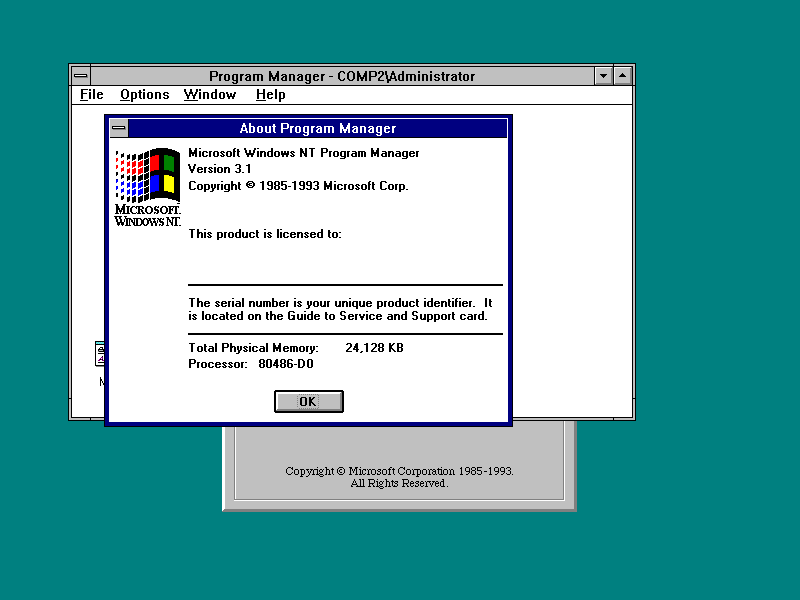This article is more than 1 year old
Windows NT: Remember Microsoft's almost perfect 20-year-old?
It all went a bit pear-shaped later... but it DID stop people switching to OS/2
Not just a pretty face
Even before it had appeared it had forced the warring factions within Unix to switch lanes and bury many disagreements: too little and too late, it turned out. The industry giants were still making lots of money from high-margin minicomputers and workstations and fat support contracts, and their engineering focus was on making Unix as robust as the minis – a job that would last well into the last decade.
To the giants, Microsoft was just a slightly sinister comedy turn, and ultimately, the established IT vendors didn't just didn't see the importance of attractive applications.
The first three years were a honeymoon for NT. Which is when people started using it. Then things really started to go a bit pear-shaped.
The reason was a familiar one for Microsoft: complacency, caused by huge shedloads of cash. At one time the plan had been to shift people from DOS-based Windows as rapidly as possible. But the competitive threat from Apple and OS/2 collapsed faster than anyone anticipated. So Microsoft was making tons of money from Windows 95 and grew complacent. After '95, it would crank out three more DOS-based versions of Windows, and it would be 2001 – eight years after NT launched – that Microsoft would finally ditch NT as an individual product.

RAM MONSTER ... Wow, 24,128KB
NT could once boast stability, but the architectural changes made in 1996 removed much of that. BSODs, once rare, became fairly commonplace, as poorly written graphics drivers ran amok. During the NT honeymoon Microsoft had made little or no practical differentiation between a server and a workstation. This ended in 1996, when it began to market the server for serious cash and limit the TCP/IP connections a workstation could make.
Bugs... what bugs?
Worse, with cash a' plenty and no urgency, Microsoft lost the ability to manage NT's development. It became project out of control. Three hundred developers had worked on NT from the time of the IBM/Microsoft divorce in September 1990 – in 10 to 12 isolated teams. This ultimately rose to 1,600 devs for Windows 2000 and from 6 million lines of code to 29 million.
The pace of development slowed. NT4 had rolled out in autumn 1996, and developers received a very crude NT5 a year later. Yet it would be three years before the code was deemed fit for release – and even then, there were 63,000 bugs still needing attention just weeks before release. In fact, it was only Intrinsa's testing tool - a source code analyser designed for embedded systems – that saved the day. Microsoft granted the Linux team a special award.
Microsoft had been breezily indifferent to security. Note the proximity of this report of the Feds investigating security holes to this strategic epiphany from Bill Gates. It's not unreasonable to infer that Microsoft had become a national security liability to USA Inc.
In getting NT consumer-ready, Microsoft had made some appalling decisions. Some, like allowing the default user to run at admin/root privilege without a password, really defy belief.
Sinofsky's legacy: Code bloat put on diet
In the past few years the code sprawl has been tamed, and it's the one bright note of Sinofsky's legacy that he took this seriously. WinMin was a long-term project to strip down the bloat away to something Cutler's founding team would recognise, a core of a kernel and components with a small footprint of a few tens of megabytes, rather than gigabytes.
Windows 7 was the first version to see the benefits of this, requiring lower resources than Vista, and Windows 8 is even nippier than 7. The result is that NT can be squeezed into tablets and phones: Windows Phone 8 today runs the ARM port of NT, smoothly and nimbly compared to Google's VM-powered Android.
(Readers with very long memories will see an irony here. The original 1981 IBM PC, which made Gates' fortune, shipped with a choice of the then-very-fashionable UCSD p-Machine, a VM-based OS, and Microsoft's MS-DOS, which was rebranded as PC-DOS. Users preferred the native code to the VM system. James Gosling would later cite p-Machine as a major inspiration for Java. Android is a Java system.)
Now look at it ... Windows NT 6.2 aka Windows 8 with Metro interface
Much of the controversy about Windows 8 is forcing a discombobulating tablet experience onto desktop users, but it's a decent tablet experience and underneath, Windows is in better health than it has been for years.
What's striking is how much the installed base casts a shadow over new development. XP has been around for 12 of NT's 20 years on the market, and it refuses to go away. With two in five PCs still running XP, Microsoft will be pressured to continue issuing patches after the 2014 cut-off date. It's a remarkable run.
There are actually many areas where NT didn't clean up: it failed to make an impact on the embedded world, where specialist systems such as QNX and VxWorks – and of course Linux – are a natural choice. Internet infrastructure largely runs on Linux too. But Microsoft won't be too unhappy, at 20, to see what the original team achieved. ®
